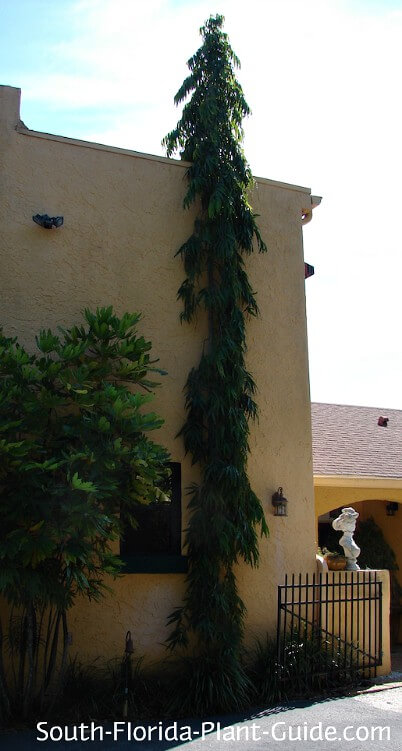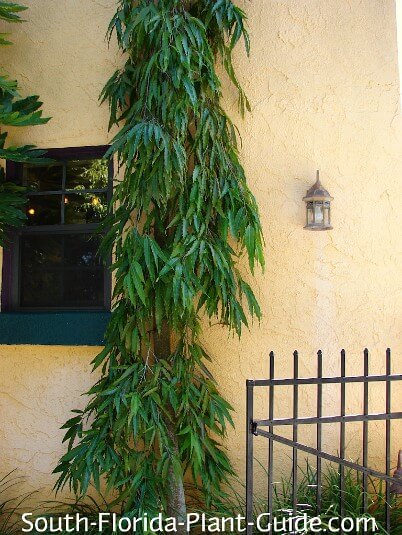False Ashoka Tree
Polyalthia longifolia 'Pendula'
The slim and lovely false ashoka tree shoots straight into the air with a narrow form of drooping branches of layered, feathery leaves.

Polyalthia longifolia is often called just "ashoka tree" but that name
actually belongs to Saraca indica. The similarity of foliage causes
people to confuse the two trees.
These are columnar trees with a weeping habit that stay full to the ground with greenery from top to bottom.
They have an artistic, charming and somewhat formal look, especially effective when planted in rows.
One of the most unique South Florida landscape trees, a false ashoka is perfect for narrow areas since it gets very tall but stays slender.
This tree works well as a subtropical substitute for Italian Cypress tree, which prefers the cooler temps of Zone 9B and northward.
In the same family as ylang-ylang tree, the tree's spring flowers are pale green and not showy.
False
ashoka is also called the Mast Tree, since builders of sailing ships
used the lightweight and flexible wood of the tall trunks to create
masts.
Surprisingly wind-tolerant for such tall, narrow trees, these are often used in group plantings for windbreak trees, privacy hedges and even to cut down on noise pollution.

Plant specs
A moderate grower to 30 feet, this tree rarely grows more than 6 to 8 feet wide.
Tropical and cold-sensitive, false ashokas do best in Zone 10B and warmer areas of Zone 10A.
These are evergreen trees that prefer a sunny location but will also grow in part shade.
Plant care
Add top soil or organic peat humus to the hole when you plant. You can also add composted cow manure to enrich the soil around the tree's rootball.
No trimming is necessary, since the tree's natural shape is a big part of its beauty.
Regular irrigation is best but make sure the planting area is well-drained.
Fertilize 3 times a year - in spring, summer, and autumn - with a top quality granular fertilizer.
Plant spacing
Here's one tree you can plant very close to the house - 3 feet out - provided it won't eventually grow into easements and gutters.
When planting in rows to form a hedge, allow 4 or 5 feet between each tree.
As a specimen you can plant 3 or 4 feet away from the nearest shrub.
Landscape uses for false ashoka tree
- lining a stately driveway
- beside a tall house
- privacy screen
- tall hedge
- architectural accent
- noise pollution screen
A.K.A. (also known as): Mast Tree, Indian Fir Tree
GOOD SNOWBIRD PLANT? YES - in warmer areas of South Florida
COMPANION PLANT SUGGESTIONS: In a formal landscape, consider variegated pittisporum, dwarf ixora, carissa, Burgundy loropetalum, and crown of thorns. For a more tropical look, try selloum philodendron, hibiscus, variegated arboricola, and crinum lily.
Other trees you might like: Southern Red Cedar, Italian Cypress
Take a break!
The ultimate guide to low-maintenance plants
and landscaping!
An ebook by
Chase Landre
author of
South-Florida-Plant-Guide.com
Learn more!
Get a greener thumb!
Want to learn more about South Florida planting, watering, fertilizing and dealing with weeds and pests?
See our Gardening How-To section for answers!
Get instant curb appeal!
An ebook by
Chase Landre
author of
South-Florida-Plant-Guide.com
Learn how to get instant curb appeal with fast growing plants and landscaping techniques!


